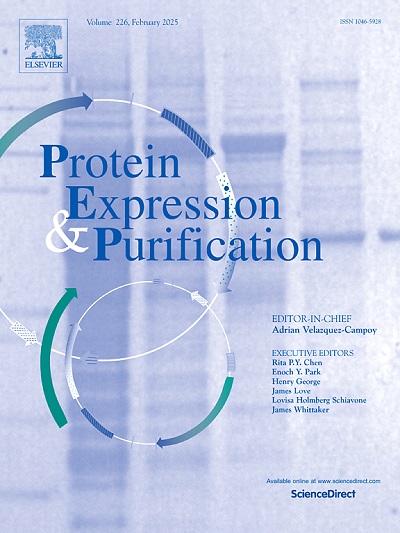Efficient production of human mitochondrial chaperonin (Hsp60/Hsp10) in Escherichia coli using a polyprotein strategy
IF 1.2
4区 生物学
Q4 BIOCHEMICAL RESEARCH METHODS
引用次数: 0
Abstract
Escherichia coli remains the leading platform for recombinant protein production, yet co-expression of multiprotein complexes often suffers from stoichiometric imbalance, presenting a persistent challenge to precise subunit assembly. Many important biological functions are performed not by single proteins but by multiprotein complexes. Studying the structure and function of multiprotein complexes would be greatly facilitated if they could be reliably overproduced in heterologous host organisms. Here, we describe a simple method for the production of the human mitochondrial chaperonin (Hsp60/Hsp10) in Escherichia coli. Rather than producing the two chaperonin subunits from a polycistronic mRNA, a strategy commonly employed by bacterial operons, we chose to make them in the form of a single polyprotein that is subsequently cleaved inside bacterial cells by tobacco vein mottling virus (TVMV) protease. In this way, equimolar amounts of mature Hsp60 and Hsp10 subunits could be ensured. The TVMV protease is produced from a second mRNA that is transcribed from the same plasmid. Although expressed at a much lower level than the polyprotein, enough TVMV protease is produced to cleave all of the Hsp10/Hsp60 fusion protein in vivo. Moreover, we show that the mitochondrial chaperonin is fully functional when produced in this manner.
利用多蛋白策略在大肠杆菌中高效生产人线粒体伴侣蛋白(Hsp60/Hsp10
大肠杆菌仍然是重组蛋白生产的主要平台,但多蛋白复合物的共表达经常遭受化学计量失衡,对精确的亚基组装提出了持续的挑战。许多重要的生物学功能不是由单个蛋白质完成的,而是由多蛋白质复合物完成的。如果多蛋白复合物能够在异源宿主生物中可靠地过量产生,将极大地促进对其结构和功能的研究。在这里,我们描述了一种在大肠杆菌中生产人线粒体伴侣蛋白(Hsp60/Hsp10)的简单方法。不同于细菌操纵子通常采用的从多顺反电子mRNA中产生两个伴侣蛋白亚基的策略,我们选择以单一多蛋白的形式制造它们,随后由烟草静脉斑纹病毒(TVMV)蛋白酶在细菌细胞内裂解。这样可以保证等量的Hsp60和Hsp10成熟亚基。TVMV蛋白酶是由同一质粒转录的第二个mRNA产生的。尽管其表达水平远低于多蛋白,但在体内产生的TVMV蛋白酶足以切割所有的Hsp10/Hsp60融合蛋白。此外,我们表明,当以这种方式产生时,线粒体伴侣蛋白是完全功能的。
本文章由计算机程序翻译,如有差异,请以英文原文为准。
求助全文
约1分钟内获得全文
求助全文
来源期刊

Protein expression and purification
生物-生化研究方法
CiteScore
3.70
自引率
6.20%
发文量
120
审稿时长
32 days
期刊介绍:
Protein Expression and Purification is an international journal providing a forum for the dissemination of new information on protein expression, extraction, purification, characterization, and/or applications using conventional biochemical and/or modern molecular biological approaches and methods, which are of broad interest to the field. The journal does not typically publish repetitive examples of protein expression and purification involving standard, well-established, methods. However, exceptions might include studies on important and/or difficult to express and/or purify proteins and/or studies that include extensive protein characterization, which provide new, previously unpublished information.
 求助内容:
求助内容: 应助结果提醒方式:
应助结果提醒方式:


